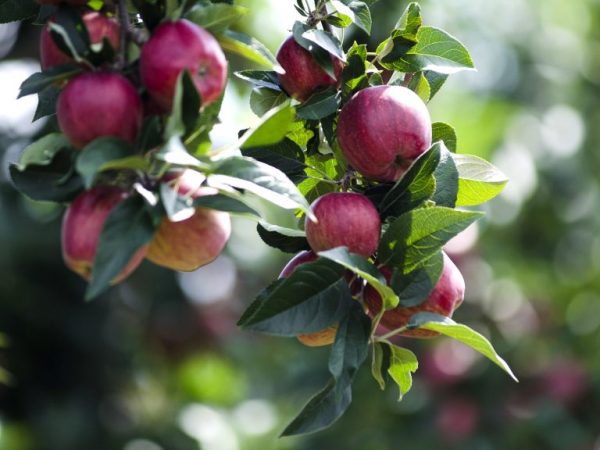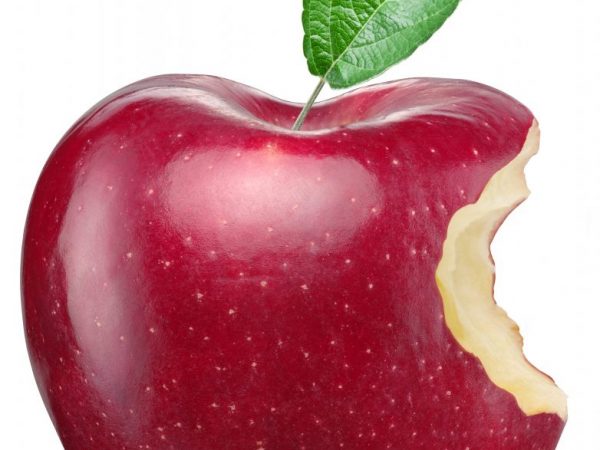Features of growing an apple tree Antey
The Antey apple tree was bred by breeders of the Research Institute of the Republic of Belarus by crossing the winter varieties Newtosh and Babushkino with the Belarusian raspberry.
- Variety description
- Appearance
- Pollination
- Yield
- Winter hardiness
- Diseases and pests
- Application and portability
- Landing
- Pick-up location
- Landing technology
- Care
- Mulching
- Top dressing
- Pruning and shaping the crown
- Preventive treatment
- Preparing for winter
- Subspecies and variants
- Features of growing in the regions
- Gardeners reviews

Features of growing an apple tree Antey
Variety description
Appearance
Wood
The tree is rarely taller than 2.5-3 m. Its crown is thin, round or pyramidal in shape and has a feature in its clear tiered structure.
This makes it easy to harvest and prune branches, forming a crown according to your preference.
Large dark green oval leaves with serrated edges have long petioles, a rounded base and a sharp tip.
Fruit
Antey apples have an attractive deep red or burgundy blush; they reach a weight of up to 250 g.
The fruits do not become smaller, even if the weather conditions are unfavorable, it is not for nothing that the name by the name of the giant in Greek mythology was chosen.
The apple saucer is of medium width and has obvious folds. The pulp is juicy, its shade is light green, the taste is sweet and sour with a pleasant light aroma. The peel is characterized by a bluish tint due to a waxy coating.
Pollination
According to the description, Antey is self-fertile, needs cross-pollination, so it is not recommended to plant the apple tree alone.
An excellent place for a devrev near autumn and summer views: Pepin Saffron, Welsey, Autumn striped, Golden summer, Papirovka's daughter, Yandykovsky, Dachny. Winter ones are useless for this purpose.
Yield
The tree shows fruit buds in the second year, but bears fruit after 2-3 years and remains in this state very constant even in those years when due to bad weather conditions in other varieties the yield is reduced.
One tree gives about 50 kg of fruit, which are harvested in September and October and stored until May without problems and tricks.
Winter hardiness
The Antey variety is a winter representative, it surpasses other apple trees with its high resistance to dampness, winter frost, it is not afraid of thermometer readings at -30 ° C, which makes it possible to grow it almost everywhere.
These wonderful characteristics are inherited from the varieties of which it is a hybrid.
Diseases and pests
In relation to pests and diseases, the tree has a weak immunity, therefore it suffers from powdery mildew, scab, and insects - aphids, leaf rollers, flower beetles, moths.
This instability indicates the need for therapeutic and preventive measures.
Application and portability
According to the description, the fruits of the fruit tree are not only suitable for eating raw, they are perfectly combined in different processing methods.
They ripen a couple of months after harvest and can be stored almost until summer. This is a great opportunity to eat fresh vitamins in winter and spring.The tree does not require high maintenance costs, and the apples themselves tolerate transportation well - these indicators attributed the species to the commercial category.
Landing

Delicious burgundy apples
The positive aspects include ease of planting and further maintenance. Planting can be carried out both in the fall and in the spring before the buds bloom.
It is recommended to choose the autumn period (after the leaves fall and a month before the frost begins).
This gives the tree time to take root better, and if it is planted in the spring, then it gives all its strength to the greens and the roots are less formed due to this.
Pick-up location
Requirements for planting:
- protection from strong winds;
- lack of groundwater;
- sufficiency of sunlight.
Landing technology
The hole should be dug a few days before planting, 60–80 cm deep and 1 m in diameter, and the seedling should be placed in water a few hours before planting. Drainage is laid on the bottom in layers, fertilized soil on top with a mound in the middle. Place a young tree so that the root collar protrudes a few cm above the ground.
Fill the hole and, as the prepared soil is laid, compact it. For the first time of growth, install a support in the form of a stick and pour plenty of water over the planted tree.
Care
The watering rate varies depending on the age of the apple tree.
- you will need 2 buckets a year.
- at 2 years old - 3-4 buckets.
- if more - 6-10 buckets.
Saplings need more care and attention than an adult plant. Water it for the first time in the spring before bud break, and then do it every 2-3 weeks.
Mulching
After watering, treat the tree trunk to clear weeds and loosen the soil. To preserve moisture in the soil, lay out mulch from hay or another type. It is important not to forget that when sprinkling mulch, it is necessary to step back 10-15 cm from the trunk in order to prevent disease, ie. prevent microbes from decomposition to get into the root.
Top dressing
A solution of superphosphate (150 g), calcium chloride (1.5 tablespoons), ammonium nitrate and nitroammophoska (1 tablespoon each) is needed for a young tree at the time the ovary is forming. Watering with infusion of chicken droppings will help a good addition of greens in the initial period of growth.
Pruning and shaping the crown
The crown of Anthea is thin and therefore does not require strong pruning, but in the spring, before the juice moves, you need to remove branches affected by sores and pests, cut off weak shoots and leave strong ones.
Make up the bottom layer from the increments of the third year and make sure that the cut is higher than the third eye. When shaping the crown, you need to rejuvenate the middle and take into account the need for lighting all the shoots.
Preventive treatment
In order to accurately avoid problems from damage by pests and diseases, it makes sense to do spraying for prevention purposes. A solution of copper sulfate in a proportion of 50 g per 1 liter of water is suitable.
If desired, you can select other commercially available products and dilute them according to the manufacturer's instructions.
Preparing for winter
Protection in the cold season is necessary for a young tree, because it does not yet have time to get stronger. The care is not difficult, and the response will please with a large and high-quality harvest. Sprinkle the circles near the trunk with a mixture of humus and compost, wrap the crown and trunk in a cloth.
Adult plants must be protected from rodents by wrapping the trunk either with tar paper, for with a fine mesh. For autumn fertilization, it is appropriate to use superphosphate diluted with water (50 g per 1 l), you can use minerals in combination.
Subspecies and variants
On a dwarf rootstock, the central trunk of the seedling is shortened to 40 cm after planting, and the lateral branches are cut to 15–18 cm and, for a wider crown in the future, they are bent to the sides so that there are wider angles in relation to the main trunk.
There is a method of growing a columnar apple tree. This method helps it grow upward, in contrast to the dwarf one, while the taste and other qualities will not change.
Features of growing in the regions
This type of healthy fruit was bred in Belarus and is especially suitable for growing in this area. Antey can be safely grown in the Ukrainian climate, guided by the general requirements for it. Russian conditions are favorable for breeding this species, given its frost resistance. Based on the pickiness and characteristics of the variety, it can be grown in almost all regions.
Gardeners reviews
The opinion about the Antey apple tree is positive.
Description of advantages: abundant yield, unpretentiousness, minimal costs and other qualities.
If you want to own a beautiful apple tree, this is ideal.

